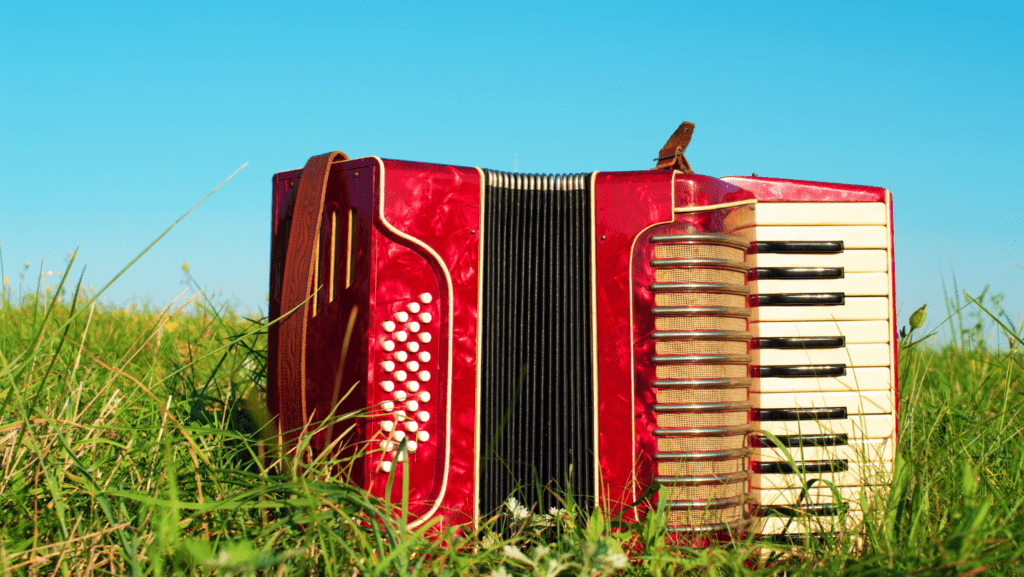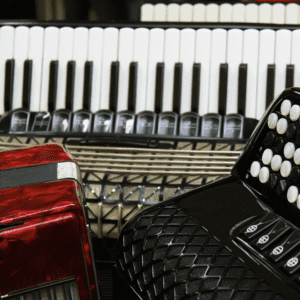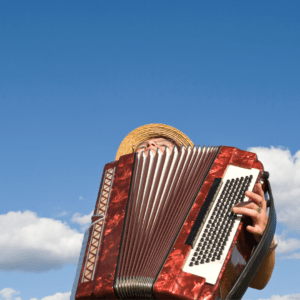
The accordion is an interesting instrument with its own melodic and harmonic character. It has a rich history and can be utilized in a whole range of different musical styles and genres. Learning any new skill can be a challenge and the accordion is no different. If you’ve decided to take up the challenge, you may be wondering how to best go about this and how long it will take.
How hard it is to learn accordion will depend on an array of different factors, including your age, previous musical experience, and how much time you have to devote to practice.
Let’s take a closer look at some factors that may affect how long it takes you to learn the accordion.
Progress On The Accordion
Learning any instrument requires a certain amount of time and dedication. There are specific techniques that you have to learn, such as note placement, how to use the bellows to produce a sound, and hand independence. This will take time and can’t be rushed. As with all music, beyond the specific skills of the instrument in question, you’ll have to familiarize yourself with the melodic and harmonic styles of the genres you want to play on the accordion.
The accordion has the advantage of being one of the few instruments that lets you play chords by pressing a single note. This means that students don’t have to learn to build chords, as they are already configured to specific buttons on the left-hand bass notes.
The advantage of this is you don’t necessarily have to learn any music theory to get going. (Although learning some music theory definitely will help you and is always advised if you want to dive into the world of music.)
So How Hard is It To Learn Accordion?
To play simple songs on the accordion should take you anyway between 2 – 8 weeks.
However, as people have different ideas, expectations, and abilities, it’s difficult to put any definite answer on it. Learning the basics and simple songs can be done in a matter of months, whilst mastery can easily take from 5 years to a lifetime. Getting clear with your expectations can help keep your morale up and help you maintain realistic expectations from your learning experience.
Things To Focus On At The Beginning Of Learning Accordion
1. Posture.
Like with a lot of instruments, your playing posture is extremely important. Wrong posture can lead to forming bad habits which over time can be very hard to correct the more ingrained they become, and can even lead to injury.
Make sure you’re holding the accordion correctly and your straps are well fitted. Failure to do this from the beginning could slow down your progress and could mean you may have to go back and correct the muscle memory you’ve formed, which can be extremely frustrating and something you don’t want to do.
You’ll need to learn how to hold the accordion when both sitting and standing to avoid back problems, pinching your arm muscles, and other general discomforts. You need to make sure your hands have total freedom to move around the instrument.
Make sure your right hand is parallel to the keyboard and your wrist doesn’t flex too much. Whilst this can be hard at first, as always, the key is consistency and practice.
2. Getting Your Hands To Work Independently.
To play the accordion, you’ll have to learn to move your hands independently, with the left handing playing the bass notes and the right hand playing the melody (usually.) On top of this, you have to make sure air is passing through the instrument via the bellows to produce the sound. To do this you need to push or pull the bellows, adding an extra layer of synchronization for the player to master.
This extra layer adds complexity to learning the instrument. But repeated practice should make this aspect second nature to you. Within 3-4 months of daily practice, you should be comfortable enough for it to start becoming second nature to you.
3. Learning Where The Notes Are.
Depending on what kind of accordion you go for will dictate the layout of the notes. Regardless of which style you choose, you’ll have to learn where different notes are located to be able to play. The more you work on this and get it firmly into your muscle memory, the better, more versatile, and proficient you’ll become on your instrument.
One benefit of the accordion over other instruments is that you can play different chords with just the push of a button. You don’t have to worry about learning how to build chords or necessarily how they work in the early stages of playing, you just have to press the buttons!
If you want to grow as a musician you’ll want to learn a bit about harmony and why certain chords sound good together and others don’t. But the accordion gives eager players the opportunity to skip this stage in the infancy of their musical journey should they wish to do so and just make music.
4. Build Up A Routine
Progressing on an instrument requires focused practiced time and not just playing. If you want to progress on the accordion then building up a good practice routine is a way to optimize your time. Make sure you incorporate a warm-up, technique building, and work on the pieces you’re learning. If you can read music, work on sight-reading, or play some pieces by ear.
Lastly and perhaps most importantly, have fun exploring the possibilities of the instrument. You can do this in whatever way appeals to you, such as composing your own simple accordion pieces, creating your own arrangements for songs, or improvising. Doing the things that keep you inspired musically is what will keep you interested, inspired, and motivated to carry on playing the instrument.
Factors That Will Affect How Quickly You Can Learn
Previous Musical Experience
It’s no secret that some people are more musically inclined than others. Some people have a talent for music, and these people will naturally learn quicker than those who have no experience.
If you’re beginning your musical journey from scratch then it’s most likely that you will take longer than someone who already has some knowledge and skills in the world of music. Also, if you’re learning the piano accordion, then previous experience with the piano or keyboard will give you a head start when it comes to learning.
Similarly, some guitarists find the chromatic button accordion intuitive as you can utilize some of the same chord and scale shapes. As such, this will give them a head start when it comes to learning note placement. However, in both instances, aspiring accordion players will still have to learn how to use the bellows of the instrument, as this is how sound is produced.
Type Of Accordion
When learning the accordion, it’s recommended that you start with an instrument with fewer keys. Whilst a bigger accordion with more keys gives you more opportunities for greater musical expressions, it’s pointless until you know what you’re doing. As such it would be prudent to get to grips with the basics before progressing to a bigger instrument. Moreover, a smaller accordion is easier to handle and will weigh less, hopefully giving you less discomfort in the early stages.
The first step of this is to get to know how an accordion works. Learn all of the parts and how they function together. The three main parts of the accordion are the keyboard, the buttons, and the bellows.
Frequently Asked Questions
What Is An Accordion and How Does It Work?
An accordion is a box-shaped instrument with keys on either side and bellows. To make sound form an accordion you need to press some of the keys whilst simultaneously getting air moving through the bellows by compression and expansion.
Accordions have three main parts; the keyboard, the buttons, and the bellows. Modern accordions are the product of many years of evolution since the 19th century. There are many different types of accordions, with the largest having 120 buttons and 47 keys, but there are many different types of smaller ones that are much easier to play.
What Are The Different Types Of Accordion?
The two types of accordions are button accordions and piano accordions. Button accordions, as the name implies, have buttons on both the bass and treble sides. Piano accordions have buttons on the bass side and a piano keyboard on the treble side.
The button accordion can be harder to learn, but easier to play in the long run. This is because the buttons are placed closer together allowing you to play faster and jump intervals quicker. The button accordion has notes laid out in duplicate rows, which facilitates the easy transposition of music for the musician. This can come in handy when playing with other musicians or singers who need to play in a particular key.
Piano accordions need a larger frame to accommodate the internal structure needed for the instrument. A button accordion can have a larger range without it affecting the size of the instrument, so you can have an instrument with a larger playing range in a smaller frame.
What Type Of Accordion Should I Get?
The type of accordion you choose will depend largely on the type of music you want to play, personal preference, previous musical experience, and perhaps the availability of teachers in your area.
There’s always a bit of rivalry in the accordion world of the benefits of the button vs the piano accordion. Both have their pros and cons, and which you choose could be decided by something as simple as whichever appeals to you more. If you have experience with the piano or any other keyboard instrument, you may find the piano accordion more appealing and intuitive for you than the button accordion.
Button accordions are typically smaller and lighter. There are two types of button accordion; chromatic button accordions and diatonic button accordions.
Chromatic button accordions play the same note whether you are pushing or pulling the bellows. Typically, they are good for jazz or classical music.
Diatonic accordions play a different note whether you are pushing or pulling. They’re good for genres such as traditional Irish music.
Piano accordions are larger and heavier than their button counterparts. If you know how to play the piano already, then the piano accordion will be easier for you to learn, and possibly more appealing.
Which Is Easier To Learn, The Button Accordion Or Piano Accordion?
Many people will find the piano accordion easier to learn because of the more intuitive layout of the piano keys than the buttons. This will be the case if you have experience with the piano keyboard.
Guitar players may find the chromatic button accordion easier. This is because of the similarity in the fingering of simple guitar chords and scales with the layout of the chromatic accordion buttons.
Once you know how to orient yourself on a chromatic button accordion and have learned where all the notes are, many players find it easier than playing a piano accordion. This is because the smaller buttons mean that it’s easier to jump between higher intervals on the chromatic than on the piano accordion, and as such gives greater musical possibilities to the player.
What Size Accordion Should I Get To Learn On?
Getting a smaller accordion with fewer keys will be easier to learn whilst you get to grips with the basics of the instrument. A smaller instrument will also be easier as it’ll weigh less and cause you less discomfort as you begin learning the essentials of the instrument.
Here is a good starter button accordion for beginners.
Is The Accordion Harder To Learn Than The Piano?
Playing the accordion requires the synchronization of multiple factors; pressing the keys/buttons with both hands and pushing or pulling the bellows. This extra dimension often means that new players find the accordion more difficult in the early stages than the piano.
The piano and accordion are in essence very different instruments. Many complete beginners to both instruments will find the accordion harder to learn than the piano. Both instruments require a similar amount of hand coordination, but the accordion requires you to control the bellows at the same time. Controlling the bellows is often the thing that beginners struggle with the most.
Whilst the piano does have three pedals to use, which dampen and prolong the tone of the instrument, it’s not necessary to learn right away. In fact, many people first get comfortable with the piano itself before learning how to use the foot pedals. So whilst the bellows are essential for producing sound on an accordion, the foot pedals on a piano are not vital, at least in the early stages.
Learning The Accordion First
Beginning with the accordion may mean you end up reliant on pressing buttons for chords as opposed to forming them yourself as you have to do on the piano. For this reason, many accordionists who later transition to the piano find the switch challenging as they’ve gotten so used to having the chords already formed for them.
There’s also the challenge of switching from a vertical keyboard to a horizontal one which perhaps shouldn’t be underrated.
Learning Piano First
Learning the piano before the accordion means you’ll have to learn how to form chords by yourself, and not have them already programmed to a specific button. This will give you an edge when later learning the accordion, as you may actually know what notes the buttons on the accordion correspond to. It’ll also help improve your ear over time as you learn to differentiate between what works harmonically and what doesn’t. Whilst this will take longer, it’ll no doubt be more beneficial in the long run for you musically.
Whilst mastery of either the accordion or piano will take a lifetime to attain, comparison can be difficult at higher levels due to the specific intricacies of each instrument.
To Sum Up
How long it takes you to learn the accordion will entirely depend on the amount of time and energy you’re willing to put into the pursuit. Whilst previous musical experience will help, there are elements of coordination that are unique to the accordion, so this is something that all beginners, no matter how experienced with other instruments, will have to contend with.
As always, consistency in practice is key. Make sure to incorporate some focused practice time into every day and you’ll be surprised how quickly you can progress.




